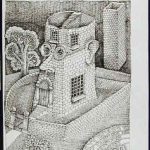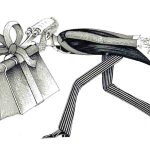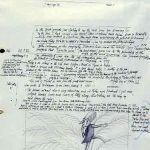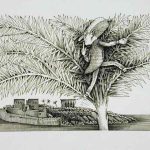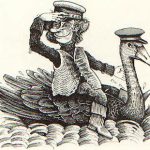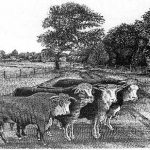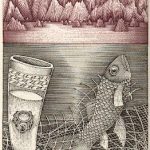John Vernon Lord, illustrator
John Vernon Lord is an illustrator, author and teacher. He has illustrated many classical texts, including Aesop’s Fables, The Nonsense Verse of Edward Lear; the Folio Society’s Myths and Legends of the British Isles and Epics of the Middle Ages. In addition, he has illustrated many classics of children’s literature including Lewis Carroll’s major works. He began teaching in Brighton in 1961 and was appointed Professor of Illustration at Brighton in 1986.
Retiring to become Professor Emeritus at the University of Brighton from 1999 onwards, he had taught in the institution under its various guises: Brighton College of Art (1961-70); Brighton Polytechnic (1970-92) and the University of Brighton (1992-1999). He has been a pioneer in the education of illustrators and a life-long contributor to the work of the illustration department. An Honorary DLitt was conferred by the institution in 2000.
John Vernon Lord ‘s work combines practice as a book illustrator; author and illustrator of children’s books and author of published articles related to the subject of illustration. Making extensive contributions to the world of contemporary poetry and narrative, his children’s books have been published widely and translated into several languages. His book The Giant Jam Sandwich has been in print for over thirty years.
His scholarly practice and research investigated book illustration and the perception of illustrated images. He was been involved in the support and formal supervision of a range of MPhil/PhD research students. A selected example of thesis titles show the wide-ranging subjects that have been covered: ‘An analysis of the elements affecting comprehensibility of illustrations intended as supportive to text’; ‘Children’s responses to illustration’; ‘Visual literacy: a study of the relationship of children and pictorial images’; ‘Apprehending Movement of the Human Figure through the Medium of Drawing, with Comments on its possible relationship to Computer Mediated Interaction’; ‘The lost arts of Islamic Calligraphy: sources of decline, suggestions for renewal’.
John Lord studied at Salford and the Central School of Arts and Crafts in London. He taught at Brighton from 1961 to 1999 and continued to lecture occasionally as an Emeritus Professor.
In 38 years as an Illustration tutor at Brighton, 1961-99, Lord attended meetings galore.”Doodling’ to assist concentration yielded an accumulation of curious drawings. The head/house on this page recalls a hat/house in Doodles and Dairies, Lord’s 1985 exhibition, which also revealed his inveterate list-making and note-taking.
He shared his reminiscences of teaching at Brighton College of Art during its 150th anniversary in 2009.
“I had no teaching qualifications when I was given the job of teaching drawing and illustration. My experience at Brighton was one of great change: from art college and polytechnic to university; different validating institutions and financial governing bodies; a succession of new buildings. The old turpentine-smelling Victorian art college building is now a sleek 21st century institution.
“I always enjoyed teaching, mostly drawing and illustration, but I also took on a number of heads’ posts at various times (ten years all told). This plunged me into the world of administering departments, schools and developing courses. Trying to manage what seemed to be ever-decreasing budgets was something of a continual tussle.
“The politicians used the terms ‘strategic downsizing’ and ‘efficiency gains’ as euphemisms for ‘cuts’. Once when estates were informed that the Grand Parade windows hadn’t been cleaned for ten years someone called it ‘deferred maintenance’.
“I spent nine years scrutinising and validating courses throughout the UK on behalf of the CNAA and it was this experience that made me appreciate what good academic fettle our courses were in at Brighton, and what good facilities we had. I was also fortunate to be teaching among a conscientious group of high-profile practising illustrators. I bless the day when my tutor at the Central School suggested going to Brighton with my folio of work, with the view to obtaining a possible teaching job there. It was essentially the students who taught me how to teach.”
John Vernon Lord, 2009
Examples of John Vernon Lord’s ‘curious drawings’ made during Brighton Polytechnic meetings
- John Vernon Lord, Motherhood and Apple Pie, 1990, Art Design Humanities Faculty Board drawing 1990.
- John Vernon Lord, ‘Sketches during Brighton Polytechnic meetings’ ‘Meeting of Directorate’ 1990
- John Vernon Lord, ‘Sketches during Brighton Polytechnic meetings’. ‘Course review committee’, 1990
- John Vernon Lord, ‘Sketches during Brighton Polytechnic meetings’. ‘staff student meetings’, pen and ink 1985
Examples from John Vernon Lord’s illustrations of Edward Lear’s Nonsense Verse
- John Vernon Lord, from the Nonsense Verse of Edward Lear, 1984
- John Vernon Lord, working sketches for Nonsense Verse of Edward Lear
- John Vernon Lord, from the Nonsense Verse of Edward Lear, 1984
- John Vernon Lord, working sketches for Nonsense Verse of Edward Lear
- John Vernon Lord, from the Nonsense Verse of Edward Lear, 1984
- John Vernon Lord, from the Nonsense Verse of Edward Lear, 1984
- John Vernon Lord, from the Nonsense Verse of Edward Lear, 1984
- John Vernon Lord, from the Nonsense Verse of Edward Lear
- John Vernon Lord, from the Nonsense Verse of Edward Lear
- John Vernon Lord, from the Nonsense Verse of Edward Lear
Various illustration works for established classics by John Vernon Lord
- John Vernon Lord
- John Vernon Lord
- John Vernon Lord
- John Vernon Lord
- John Vernon Lord
- John Vernon Lord
- John Vernon Lord
- John Vernon Lord
- John Vernon Lord
- John Vernon Lord
- John Vernon Lord
Works by John Vernon Lord
- John Vernon Lord, Beneath the tree, black and white drawing, 1966.
- John Vernon Lord, illustration from The Runaway Roller Skate
- John Vernon Lord, The Giant Jam Sandwich, cover
Reviews
The foremost Edward Lear scholar and biographer Vivien Noakes wrote of The Nonsense Verse of Edward Lear:
“I find Mr. Lord’s work irresistible. Most new illustrations of Lear’s verse are enjoyable artistic exercises which have little to do with the writer. These illustrations, however, are no superficial ornamentation. Mr. Lord has soaked himself in Lear and his work, and has brought to his drawings an affectionate insight and understanding of the man and the Nonsense writer. He has set out to provide a new perspective to Lear’s verse and the universe he created, and in this he succeeds splendidly. Not for anything would I have missed his old man on the Border or his old person of Skye, while his Scroobious Pip is all that anyone could wish’. They are not Lear’s illustrations, but I think he would have approved.”
(Vivien Noakes, ‘Stuff and Nonsense’, Punch, 29 January 1988)
Another extract from a review of The Nonsense Verse of Edward Lear by M.C. in Junior Bookshelf, October 1984:
“Physically the new Lear is a book of the highest distinction. Paper, print, design are all of great excellence, making this – if not of immediate appeal to children – a book for connoisseurs to gloat over. John Vernon Lord gives us almost all the verse, together with a thoughtful introductory essay, a book list and an exceptionally good index. Perhaps his most remarkable editorial achievement is in the arrangement. He gives us the limericks in batches, divided by the longer poems. The limericks themselves have been put into groups – although this device has not been pursued pedantically – according to theme. So we have, for example, five pages of poems about eating, two on walking, five of people (and a cow) up trees, two on despair, and so on. It might be feared that this merely draws attention to Lear’s repetitiousness. Far from it; it brings home to the reader his infinite resourcefulness and the concentrated oneness of his curious philosophy. Here is altogether a bigger Lear than we have sometimes allowed ourselves to believe in. For many this edition will be memorable mainly for Mr Lord’s illustrations. An artist re-illustrates Lear at his peril, for the author’s original drawings are surely definitive. Nevertheless plenty of brave men have taken on the task from Leslie Brooke to Edward Gorey, and Mr Lord takes his stand with the best of them. He draws always in black and white with the greatest power and precision. He emphasises the essential seriousness of Lear’s nonsense, and he builds up cumulatively a picture of a society in which supremely individual eccentrics are put down by a conformist establishment, the ‘they’ whom Mr Lord portrays not as faceless bureaucrats but as only too clearly delineated hostile persons. It is a performance of the greatest virtuosity, one that will not please all traditionalists but for some will unveil a new and bigger Lear.”
(M.C., ‘The Nonsense Verse of Edward Lear’, The Junior Bookshelf, October 1984)
Of Aesop’s Fables the poet Charles Causley has written:
“For his handsome Aesop’s Fables John Vernon Lord has chosen 200 of his favourites, now retold in verse by the redoubtable James Michie. The result is a triumph. The tales rise freshly from the pages as though written by some master today… Daringly John Vernon Lord sets the scenes in an around his home in the village of Ditchling. It might not be thought that the exotic fauna of Asia Minor could inhabit with such ease the intensely English landscape of Sussex, but occupy it, and with great naturalness, it does. The assured and finely detailed black and white illustrations complement Michie’s verses with such delicacy, wit and sympathetic understanding that the work of artist and poet seem the work of one. How often may this be said of writer and illustrator?”
(Charles Causley, ‘Master fable-maker’, The Times Educational Supplement, 16 February 1990)
Another extract from a review of Aesop’s Fables by M.C. in Junior Bookshelf, April 1990:
“Admirable as are James Michie’s poems, witty, economical, pointed, this is John Vernon Lord’s book. As in his edition of Edward Lear, he makes us look afresh at familiar pieces and sharpens our understanding of their true meaning. The scholarly introduction is evidence that this success is no accident. Mr. Lord has thought about Aesop a great deal and recognised the relevance of the Fables in every age. With that in mind – and no doubt because this is what he likes to draw – he sets the fables in his own Twentieth century Sussex, their timelessness somehow underlined by the homely contemporary scenes. Aesop was a hard-headed realist and clear-sighted social commentator, one whose message is not to be prettied up. The black and white pictures are exquisitely done, and are set into the text with enormous skill. Type, printing, paper and casing are all of the highest quality. It all adds up to a beautiful and desirable book; an expensive one too, which is a pity because the book deserves a wide distribution, but sadly quality of this kind can be had only at a price. One for the collector, and for the special child on a special occasion. Set the cost against that of a video or a meal-out and consider which will give the most lasting satisfaction.”
(M.C., ‘Aesop’, The Junior Bookshelf, April 1990)

